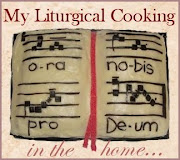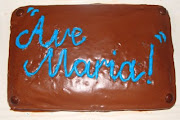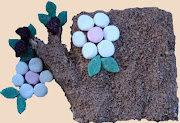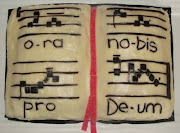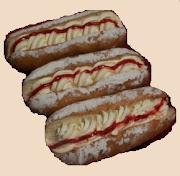The Mass setting for the felt dolls with altar.
Some may remember my posting last year, where I showed how I made a felt doll set of apostles, Our Lady and the Holy Spirit for children to interact with in a catechesis setting. If you did not see it, here is the link to my tutorial. You can see below a photo of what I made.
To see closer detail, click on images to enlarge.
Felt apostle dolls with Holy Spirit and tongues of fire
So what this posting is about is the 'home' and 'setting' made for these dolls. The dolls were to be presented in a Last Supper or Pentecost setting (both being in the Upper Room) and then also a Mass setting (I'm yet to make the priest doll).
The Last Supper setting with Last Supper Table.
The first photo above is the completed Mass setting, that features the back wall of a church, with stained glass windows, statues and in the centre is the altar.
The photo just above is of the Last Supper setting, with three open windows looking out onto the Garden of Olives and the Jerusalem wall and Temple. In the centre is the Last Supper Table. The Apostles and Our Lord can be placed around the table for a re-enactment of the Last Supper. It also can be used for the Pentecost scene, which took place in the Upper Room as well.
This was not hard to make, it was not expensive. I used 3 MDF boards (very cheap) and 2 metres or so of wood and a little bit of square doweling, some nails, a saw. Other essentials include pencil, rubber, ruler, tracing paper and school acrylic paints.
The picture you see above is the back wall, on one side I painted the Church scene, then I flipped it over and painted the Last Supper scene. The back wall panel buts in between two strips of square doweling wood, that were nailed side by side length-wise at the back of the floor area, the spacing between the two pieces of doweling is the exact thickness of the MDF board, so it fits in firmly and does not move. When you are packing the display up, you can take the back wall out all together. Have a look at the photo below, you will see the square doweling at the base of the wall, I have painted it with 'stone brickwork' to disguise it's functional purpose.
The photo above is also a good shot to see how I made the altar/Last Supper Table, as they are one and same thing. On one side I have painted a 'IHS' motif that you would often find on a Church altar. On the other side, it is plain, so that it just looks like a wooden table. The altar was made from left over MDF board, it features as the top of the table and the base. In between the two pieces of MDF board is three pieces of wood, two are the same size, the third is slightly smaller, no really reason for that, just it gives a nicer appearance. The three pieces of wood were placed together (smaller piece in the middle) and then I nailed the MDF board on top of the 3 pieces and then flipped up side down, and nailed the MDF board base. I painted it mission brown and then painted the IHS motif on the Church altar side. The photo below features the altar side, front on.
The next seven photos, feature the painting of the Church side, back wall. What I did, was do an internet search on stained glass windows and Church statues. I found a lovely Holy Spirit window image, saved it to my computer. Then I found a lovely image of a set of 3 stained glass windows which featured the Crucifixion. Then I found an image of a St Therese statue and St Francis Xavier, two Australian patrons, which often see in many Churches throughout Australia.
Here is a nice close up of the Holy Spirit/Trinity stained glass window, this one I drew free hand and painted it with simple, school acrylic paints.
Here is a close of the St Francis Xavier statue, with the statues, I printed up the images to the size I wanted to draw and paint them, but I mirror flipped them before printing. The reason for mirror flipping was because I wanted to trace the statues and put onto the board that way, less chance of mistakes. Then I painted them both to look like they were stone statues.
Here is the close up of St Therese of Lisieux.
You can see how I've drawn and painted the stone brickwork around everything, I used three different shades of grey.
When it came to the three stained glass windows set, I free hand drew the windows, the only thing I traced was the Crucifixion scene. I changed a few little things here and there, in fact, I printed up two different stained glass windows, using the motifs out of the one and using the colour scheme and glass patterning, from the other.
A photo of the all the stained glass windows.
All finished, and ready to start on the reverse side ~ the Last Supper scene is next.
Here is the three windows looking out onto the Garden of Olives, the Jerusalem wall and Solomon's Temple rising above the walls. I just did an image search of the Mount of Olives and came up with a photo that looked like what you see here. Of course, the modern photo featured the muslim Dome of the Rock where you see Solomon's Temple in this picture! So I did a search on what Solomon's Temple was supposed to have looked like and drew the top of it, where would normally be today, the Dome of the Rock. You can see pencil pines and the olive trees in the forefront, laden with olives.
In this photo you can get an idea of how I built the base. It featured two big pieces of MDF board. So I took the MDF board base, and nailed timber around the two sides and the front, I set them back from the edge by about a couple of cms (inch or so). Then I nailed the top MDF board on top, which was to be painted as the stone floor. The back side did not have a strip of timber nailed along it, as I wanted to use it as an opening to place the felt dolls for storage. I used some left over MDF board to make a sliding door. In this photo you can also see the second strip of square doweling, that holds the back wall firmly in place on the base.























































































































